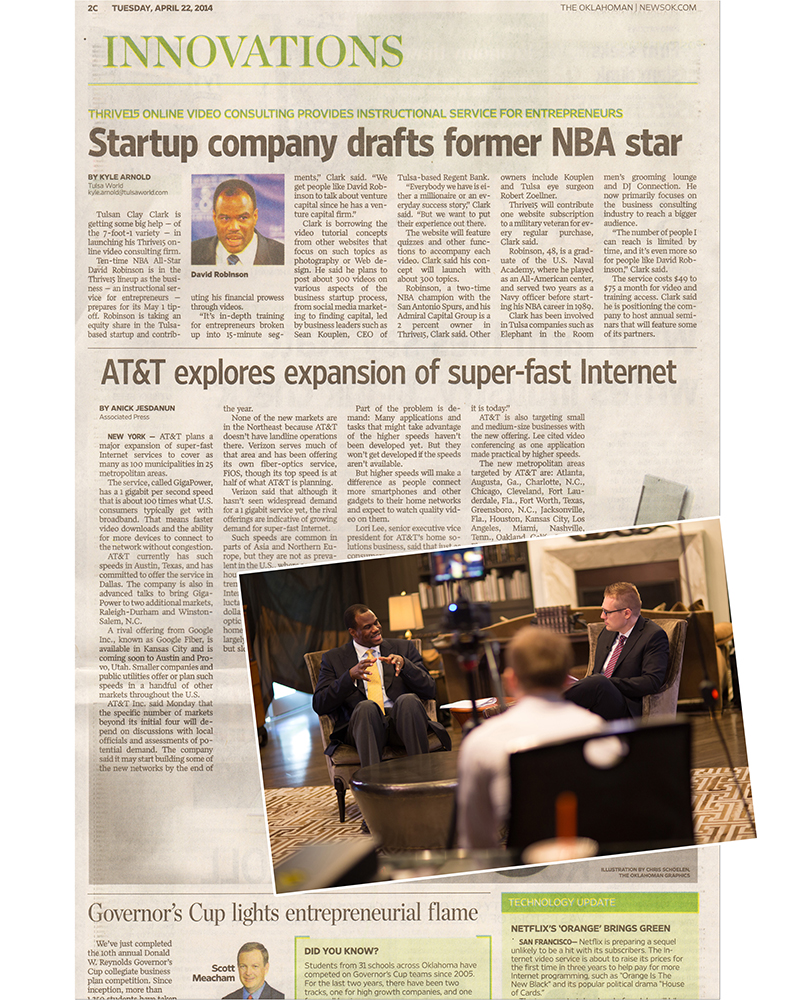 One of the finest Ohio business colleges, Thrive15.com presents the following transcript featuring Clay Clark, US Small Business Administration Entrepreneur of the Year, Business Coach Expert, and Tim Redmond discussing cash flow statements.
One of the finest Ohio business colleges, Thrive15.com presents the following transcript featuring Clay Clark, US Small Business Administration Entrepreneur of the Year, Business Coach Expert, and Tim Redmond discussing cash flow statements.
Clay Clark: Hey, my name is Clay Clark and I’m the CEO of Thrive15.com and your business coach. And, today, I am joined with Tim Redmond. This is a beautiful man with a plan who I used to intern for his company back in the day. He grew his company from 2 people to 450 people before they ultimately sold the business. I think they all moved down to Mexico and are sipping margaritas full time. But, the point is, he has had a lot of success. Today, he is going to be teaching us, specifically, about the concept of building a cash flow statement.
He’s going to be teaching us, specifically, how to make one of these statements where you know how much cash is coming in, how much is coming out, where the cash is going. If you don’t know this stuff, it’s impossible to start and grow a successful business. Trust me I am a business coach.
It might not be the most exciting topic in the world, but I can tell you this, it’s exciting making money, so you want to pay attention.
Tim Redmond, how are you sir?
Tim Redmond: Doing great. You doing good?
Clay Clark: I’m doing well as a human and business coach. I feel like that might have been the perfect handshake and I feel like it’s off to a good start here.
We’re here to talk today about cash flow statements. A lot of entrepreneurs are watching this. A lot of aspiring entrepreneurs have no clue what this word means. So, if someone says cash flow and they hear, “Whah, whah, whah, whah, whah, whah, whah, whah, whah, whah, whah, whah, whah, whah, whah, whah, whah, whah, whah, whah, whah, whah, whah, whah.” Doesn’t matter when they hear it, they just don’t know what that means. Because they don’t know what it means, it’s hard for them to master it. It becomes a source of anxiety so we avoid it. We’re going to talk about cash flow.
So, Webster and his gang of dictionary writing buddies, they define as cash flow as a measure of an organization’s liquidity that usually consists of net income after taxes plus non-cash charges against income.
What are talking about? What does the word liquidity mean?
Tim Redmond: Alright, liquidity is your capacity to use money.
Clay Clark: This business coach says, OK.
Tim Redmond: Really. So, we believe, you and I believe cash is king in the business. We want to manage with good systems. We want to manage with discipline and implementing good systems and sales and marketing. In all that we do to help our clients, help our thrivers here. What we want to do, the cash flow statement is rarely referred to because a lot of people just don’t understand it. Even accountants don’t understand it. All’s we’re doing in a cash flow statement is we’re saying, “Listen, here’s all the major activities of what happened with cash.” Here’s where it went and here’s where it came from. It’s getting a really good idea of what all happened to cash during this certain period of time and here’s the net cash activity. Let’s take your cash balance at the beginning of the period and it should equal your cash balance at the end of the period.
Clay Clark: Why do I have to know this?
Tim Redmond: It is very important. In cash management, most businesses have to shut down because they run out of cash. Now, I don’t believe that most businesses have problems because it’s a cash flow management. It’s because it’s a lack of management or lack of business no-how. Or, lack of discipline. It always shows up your bad decisions or sometimes there’s unpredictable things that happen in the economy that we don’t anticipate. Whatever it may be, the series of decisions in your business are always shows up in the cash account. It always shows up in the cash account because really eventually we’re going to sell our product. We’re going to collect our receivable. We’re going to pay our debt and it’s all going to come in and out of that cash account.
Does your business maximize its finances? Learn how at the most practical Ohio business college, Thrive15.com.
Clay Clark: Makes sense. Now, Tim, let’s kind of dive into this cash flow statement here.
Tim Redmond: Yeah.
Clay Clark: Let’s just kind of work through it methodically. Kind of explain to me what all these things mean and let’s just assume nothing. Let’s assume that I don’t know what any of these terms are and let’s go through it.
Tim Redmond: So, with a cash flow statement, really we’re wanting to know what happened to our cash during a certain period of time. Like an income statement, a cash flow is over a certain period of time. It’s not like a balance sheet to say, well, here’s our net worth at this one point. This is over a period of time, what happened with our cash. There’s 3 main divisions of a cash flow statement or 3 main ways that cash is used in a business.
Clay Clark: OK.
Tim Redmond: Alright. The first one’s from operations.
Clay Clark: OK.
Tim Redmond: Operations are like, well, what are you in business for? Well, I’m here to sell hot dogs. That’s what we’re talking about before.
Clay Clark: Yeah.
Tim Redmond: Based on the amount of hot dogs I sell, and based on the net income that I have I’m going to show … Let’s say that I have a net income of $2,000 that I made over this one year period of time during the year we’re talking about $2,000 of net income. So, I’m going to put that on there. OK. Now there’s some other elements. Some non-cash items in your income statement. I don’t want to go into those so much but depreciation, amortization, things that really don’t cost you money in your expenses but the IRS allows you to deduct them and the general accounting principle. Generally some accounting principles allows you to deduct them. They don’t really cost you cash. Like, depreciation is just an amount, let’s say that you have a car and you’re depreciating it $2,000. You didn’t lose $2,000, you didn’t have to pay out $2,000. It just reduced the amount of money that you spent on that depreciation.
So, those things are actually added back into the net income. I didn’t show those. But, for real anal kind of people that really know all this stuff already, we’re keeping it relatively simple.
So, we have a net income, this is from our operations. Then, we’re going to invest in our business and we’re going to get new loans and pay off those loans. Those are the 3 areas is from selling stuff and our expenses having to do with that, OK. Then, investing, expanding our business, and then paying off our debt or getting new debt from it. That’s really the 3 areas. So, let’s just say in this example. Let’s say that we sold our old concession truck.
Clay Clark: Yeah.
Tim Redmond: And, it was an old beater. It was worth $5,000. We got some sucker to buy it for $5,000 and we’re happy, he’s happy. Everybody’s happy.
Clay Clark: We have a sentimental attachment though to the food truck. You can’t really put a price on that. I mean, because we’ve bought it, so.
Tim Redmond: I think that’s going to be another Thrive item that … another Thrive session that I’m going to have you do.
Clay Clark: About the sentimental value of … OK … by myself, a business coach.
Tim Redmond: By yourself.


 One of the finest Ohio business colleges, Thrive15.com presents the following transcript featuring Clay Clark, US Small Business Administration Entrepreneur of the Year, Business Coach Expert, and Tim Redmond discussing cash flow statements.
One of the finest Ohio business colleges, Thrive15.com presents the following transcript featuring Clay Clark, US Small Business Administration Entrepreneur of the Year, Business Coach Expert, and Tim Redmond discussing cash flow statements.